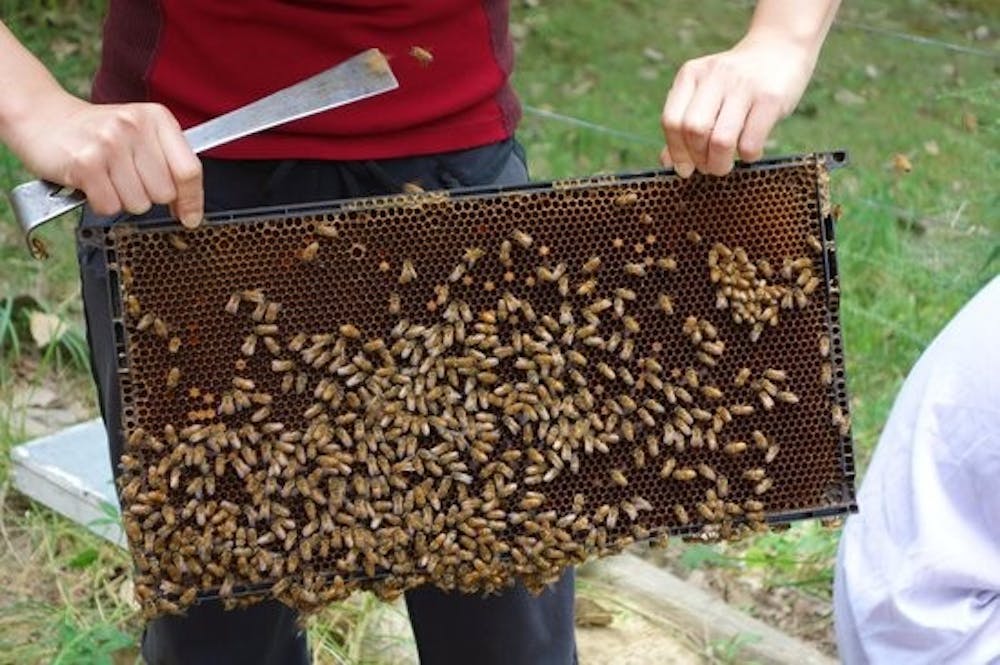It’s no accident people call their loved ones “honey,” according to beekeeper Tracy Hunter.
At the Venue Fine Arts and Gifts, Hunter stood before a small crowd Tuesday evening to present “How Sweet It Is: A Presentation All About Honey.”
But the discussion wasn’t strictly built around the nitty-gritty of Hunter’s day: a sunrise to sunset routine of checking on bees, operating machinery and taking business calls. Rather, Hunter looked to honey’s source, the honeybee, to examine the wonders of the insect and the perils it faces today.
As fourth generation beekeepers, Tracy Hunter and his wife Christina operate the 95-acre Hunter’s Honey Farm in Martinsville, Indiana. Their family has been producing honey for more than 103 years in Indiana, Hunter said. As a young boy, he grew up helping his grandfather harvest honey to be sold in local stores and orchards, even off of their front porch.
“My grandfather was a beekeeper and a schoolteacher in southern Indiana,” Hunter said. “My mother was a beekeeper and schoolteacher in Mooresville. Now, we are beekeepers and schoolteachers in Morgan county.”
In the presentation room sat Diane David, volunteer coordinator at WonderLab and a fellow honeybee enthusiast. Hunter and David exchanged a few words before the program, a “bee lingo” of sorts that would likely appear cryptic to someone unfamiliar with beekeeping.
“It’s like ‘Where’s Waldo’, trying to find her,” David told the group. “If you lose her in the swarm or you’re relocating the hive, she may get damaged by a bird and that’s it.”
What David was referring to was the queen, a docile “egg machine” in the honeybee colony with the sole responsibility of producing more than 2,000 eggs per day. The “swarm” is a phenomenon that occurs when a hive becomes overcrowded and bees must relocate, Hunter said. It’s not an uncommon sight to find a swarm gathering on tops of cars in downtown Bloomington, for example.
For some, the thought of a bee swarm is terrifying. Hunter, however, estimates he is stung around three times per day on the farm.
Occasionally, Hunter said a customer will have a specific request: to be “professionally” stung.
“I do get some people suffering with arthritis or other conditions, like MS, who come to me and ask to be stung for its therapeutic benefits,” Hunter said.
However, Hunter’s main priority is manufacturing the goods his farm is known for: everything from honey teriyaki sauce to beeswax candles, honey pecans and honey lip balm. In addition to foods and gifts, Hunter’s Honey Farm offers a wide array of services.
For the public, there are five different tours to choose between — in the Honey Tour, for instance, one can sample different varieties of honey, witness live honey extraction from a hive and make their own beeswax candles.
For agricultural companies and corporations, hive rental is a popular option to ensure that all crops are properly pollinated.
“If a cucumber flower is properly pollinated by a honeybee, the cucumber will actually grow straight, so the demand for (hives) in pickle companies is very high,” Hunter said.
Several local companies in Bloomington are outlets for Hunter’s Farm honey: FARMbloomington, Sahara Market, Bloomingfoods, Soma Coffee House and Jice Bar and Upland Brewing Company. Seasonal outlets include the weekly Bloomington Community Farmers’ Market and the upcoming Morgan County and Indiana State Fairs.
Honey and pollen, which do not spoil, have been longtime health foods.
"It's like holding a whole health food store in the palm of your hand—the human body can survive on honeybee pollen alone as food," Hunter said. "This is because it is the only food which contains, in perfect balance, all 22 known essential nutritional elements."
In addition to producing vitamin and nutrient-rich honey, honeybees account for 80 percent of insect pollination in the U.S. National Geographic estimates that this service is valued at $15 billion per year.
“Our goal is to give people the opportunity to experience the wonderful world of honeybee products,” Hunter said.






